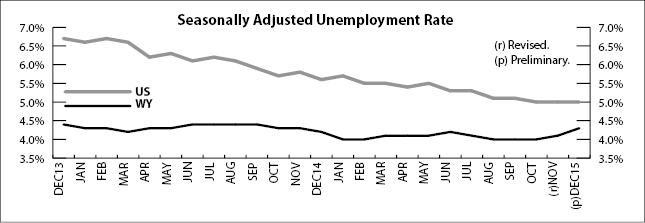Wyoming Unemployment Rate Rises to 4.3% in December 2015
The Research & Planning section of the Wyoming Department of Workforce Services reported that the state’s seasonally adjusted1unemployment rate increased significantly from 4.1% in November to 4.3% in December. Wyoming’s unemployment rate was slightly higher than its December 2014 level of 4.2% and much lower than the current U.S. unemployment rate of 5.0%. Seasonally adjusted employment of Wyoming residents decreased, falling by an estimated 2,820 individuals (-1.0%; a statistically significant decrease) from November to December.
From November to December, most county unemployment rates followed their normal seasonal pattern and increased. As colder weather sets in, seasonal job losses are typically seen in construction, professional & business services, and other sectors. The largest unemployment rate increases were seen in Johnson (up from 4.3% to 5.1%), Sublette (up from 4.9% to 5.5%), Big Horn (up from 4.2% to 4.7%), and Converse (up from 3.8% to 4.3%) counties. Unemployment rates decreased in Teton (down from 6.8% to 4.0%) and Niobrara (down from 3.0% to 2.9%) counties.
From December 2014 to December 2015, unemployment rates rose in 12 counties and fell in 11 counties. The largest increases occurred in Natrona (up from 3.9% to 5.5%), Converse (up from 3.0% to 4.3%), Campbell (up from 3.2% to 4.3%), and Sweetwater (up from 4.0% to 5.1%) counties. Sizeable unemployment rate decreases were observed in Teton (down from 5.0% to 4.0%), Lincoln (down from 5.3% to 4.8%), and Laramie (down from 4.5% to 4.0%) counties.
The lowest unemployment rates were found in Albany (2.9%), Niobrara (2.9%), Goshen (3.1%), and Weston (3.3%) counties. Fremont County posted the highest unemployment rate (6.0%). It was followed by Natrona (5.5%), Sublette (5.5%), and Uinta (5.2%) counties.
Total nonfarm employment (measured by place of work) fell from 292,300 in December 2014 to 285,800 in December 2015, a decrease of 6,500 jobs (or -2.2%; a statistically significant decrease).
1Seasonal adjustment is a statistical procedure to remove the impact of normal regularly recurring events (such as weather, major holidays, and the opening and closing of schools) from economic time series to better understand changes in economic conditions from month to month.


